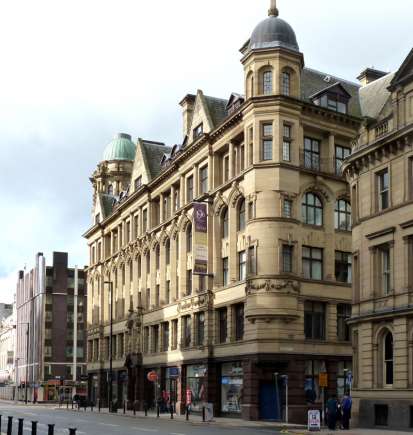Royal London Buildings 196 Deansgate Manchester
Located on an island site bounded by Deansgate, Quay Street Little Quay Street and Atkinson Street, the buildings was designed in a free Baroque style by Charles Heathcote and Sons and was first offered for letting in July 1904 as shops with large basements, offices, and warerooms. [Manchester Guardian 23 July 1904 page 2]
Sandstone ashlar above polished brown granite to the ground floor on the three main elevations. As was typical in Manchester, the “back” elevation to Little Quay Street is built of brick with stone banding, and has little architectural pretention. However it does possess large areas of glazing, suggesting intended warehouse use but whether this is an original feature or a later alteration is unclear. Each corner of the building is marked by turret features with a higher and more elaborated domed tower at the junction of Deansgate and Quay Street. This latter has been truncated – see early photograph in Manchester Local Images
Royal London Buildings were built as part of the veneer of respectability, intended to hide one of the poorest areas of Manchester - the area between Deansgate and the River Irwell. Here lived those badly paid, but nonetheless essential, workers required in the smooth running of a Victorian city – the cleaners, caretakers and chambermaids, the casual labour employed in the loading and unloading the boats on the canals and river, and moving meat carcasses at the abattoir. The land along Deansgate between Quay Street and Hardman Street is shown as vacant on the 1890 plans (whether part of the Deansgate widening is unclear) and seemingly remained so until the final years of the nineteenth century when the Inland Revenue Offices at 184-186 Deansgate, (1894-1896) were constructed followed by the Royal London Buildings c1904. Those occupying the offices on the upper floors as listed in the 1909 directory have little connection with the traditional industries of the area. Included are Bovril Limited; Diespeker Ltd, mosaic artists; a map publisher, colliery owners, ship owners, and the Lancashire Electric Power Company etc. The Royal London Friendly Society occupies the ground floor unit only.
